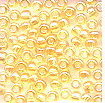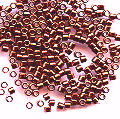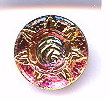Categories
Categories
- Home
- KITS
- BEAD WEAVING
- NDEBELE CELEBRATION BRACELET INSTRUCTIONS DOWNLOAD, (1 unit)
NDEBELE CELEBRATION BRACELET INSTRUCTIONS DOWNLOAD, (1 unit)
Product Description
Ndebele Celebration Bracelet
Designed by: Warren Feld
BW1-SOM-03
ADVANCED BEGINNER/INTERMEDIATE LEVEL
-- Bead Weaving Sequence
-- Stitch of the Month
-- Lesson: Ndebele (also called Herringbone)
-- Bracelet
Express the joy in your life with this South African ritual-style piece! Utilize several variations of the Ndebele Stitch, including flat, 3 types of spiral tubes, rapid and slow increasing and decreasing.
NOTE: Regular retail and wholesale store discounts do not apply to kits.
View Warren as Guest Artist on JTV.com Jewelry Television's show "Jewel School"
as he discusses his specially adapted Celebration Bracelet project for Jewelry Television.
Mother's Celebration Bracelet
The Ndebele CELEBRATION BRACELET KIT
Instructions to make a 7 3/4" bracelet
(This bracelet is meant to be worn loosely around the wrist,
so 7 3/4" would work well with a 7" wrist.)
Supplies to make up to an 8 3/4" bracelet
|
PLEASE NOTE: Sometimes, because of erratic supplies of beads and othermaterials,
we will need to substitute something of similar color and quality.
#1 CHARTREUSE / RASPBERRY / OLIVINE / PURPLE IRIS PALETTE
|
Colors may appear differently on different monitors.
#2 GREEN / OLIVINE / FUCHSIA / LILAC PALETTE
|
Colors may appear differently on different monitors.
FORMAT OPTONS
(1) Instructions Digital Download
About the Kit...
The Ndebele Stitch, (also known as the Herringbone Stitch orBasketweave Stitch), originates from South Africa from the Ndebele people. This stitch is known by the herringbone or zig-zagpattern the beads make when stitched together.
This stitch is very versatile. There are many variations on the stitch, which can result in different patterns and textures, as well as looser or tighter tension. The Ndebele stitch is easy to incorporate with otherbeadweaving stitches, such as peyote, right angle or brick, off thendebele weave.
The stitch is very soft and fluid. It results in a very beautiful texturing and patterning. A lot of thread shows in this stitch, and, in this case, is a charming part of the whole effect.
The beads sit in regular columns in angled pairs, forming a "V" (thus, herringbone,) shape.
Ndebele usually begins by creating a row or two of ladder-stitched beads. The stitch will work with any shape or size bead. Evenly sized beads will result in evenly sized beadwork. Round beads (as opposed to more squarer shapes) show less gaps between each pair of diagonally-stacked beads. With round beads, the piece feels a little more flexible.
Ndebele is easily worked flat or tubular.
Traditional Ndebele beadwork can also be very flat and 2-dimensional. In contemporary jewelry design, adding a sense of 3-dimensionality, as well as movement, are important design elements. Here the somewhat free-flowing flat strips and tubes, as well as the raised button, helpcontemporarize the piece.
In our Ndebele Celebration Bracelet, we get an opportunity to learn several variations on Ndebele. These include 3 different ways to make tube shape, including a basic tube, a basic spiral tube, and a soft spiral tube. We learn to increase the number of beads in the width of our piece using a gradual increase strategy. We also learn to decrease the number of beads in the width of our piece using a rapid decrease strategy. We learn to make a fan or arc by varying the sizes of our beads within our rows. We learn to create a "negative space" in order to provide a "button hole" for our clasp. We also learn to make a simple decorative edging effect on the sides of our bracelet.
This bracelet is meant to be worn loosely around the wrist.
In the Ndebele Celebration Bracelet project...
LearnToBeadGoals:
- History of Ndebele
- Ndebele bead weaving basics
- Managing Thread Tension
- Reading a Pattern/Creating a simple figural representation
- Flat and Tubular and Spiral and Fanning Ndebele variations
- Increasing and Decreasing with Ndebele, both rapid and slow
- Adding a simple edging effect
- Adding a button clasp, and creating a negative space as part of the clasp assembly
- Discussion of when Ndebele works well
Instructions Contents:
SUPPLIES LIST
I. Planning Your Project
IA. Conceptualizing Your Piece
IB. Measurements
IC. Selecting Materials
ID. Sketching a Pattern or Graph
IE. Identifying Potential Areas of Weakness within Your Piece
IF. Visualizing Your Process
IG. Organizing Your Work Space
II. Beginning Your Project
IIA. Basic Steps
1. Review our Graph Pattern above
2. Build your 2-Row Ladder
3. Create an Ndebele Fan
4. Begin the flat Ndebele section with decorative edging
5. Begin a Gradual Increase in Row 8
6. Row 9 continues this Gradual Increase
7. Row 10 finishes this Gradual Increase
8. Beginning with Row 11
9. Create a flat strip, a basic plain tube, a basic spiral tube and a soft spiral tube, and, finally, a 2nd flat strip
10. Reconnecting all the flat and round tubes
11. Beginning our 7-Color-Band Flat Ndebele with Row 105
12. Continuing with our 7-Color-Band Flat Ndebele, Rows 106 -116
13. Creating the Row which defines the bottom of our button hole, Row 117
14. Creating our Button Hole (Negative Space), Rows 118-129
15. Close the Button Hole (Negative Space) by beginning Rapid Decrease
16. Row 133
17. Add Ndebele Fan (or Arch) to end
18. Add Button
IIB. Dealing with Contingencies
IIC. Finishing Touches
III. Summary of Learning Objectives You Have Met
After Accomplishing This Project IV. Next Steps
IVA. Suggested Readings
This Ndebele bracelet is a symbolic representation of joy in a woman's life. The selection of colors for the 3 central tubular components represent things which the woman celebrates in her life, about her life, and around her life. These may be colors associated with children, grandchildren or friends. They may be favorite colors, or colors of favorite flowers or other objects. They may be colors associated with important emotions, rituals or times. They may be colors associated with events or places experienced when traveling.
While the "design" of the bracelet is from the woman's perspective, the "wearing" of the bracelet is unisex. A man would be equally as comfortable wearing this bracelet, as would a woman.
| LEARNING OBJECTIVES | STITCH OF THE MONTH | ||
|
| BEGINNER | INTERMEDIATE | ADVANCED |
| TECHNICAL MECHANICS | |||
| 1. Managing Thread Tension | BEGINNER |
|
|
| 2. Holding Your Piece To Work It | BEGINNER |
|
|
| 3. Reading Simple Pattern, Figure and/or Graph | BEGINNER |
|
|
| 4. Selecting Materials | BEGINNER |
|
|
| 5. Identifying Areas of Potential Weakness, and | BEGINNER |
|
|
| 6. Determining Measurements, including Width and Length of a Piece, Especially In Relationship To Bead Sizes | BEGINNER |
|
|
| 7. Finishing Off Threads in Piece or Extending by Adding Threads | BEGINNER |
|
|
|
| |||
|
| |||
| UNDERSTANDING CRAFT BASIS OF STITCH | |||
| 1. Starting the Stitch | BEGINNER |
|
|
| 2. Implementing the Basic Stitch | BEGINNER |
|
|
| 3. Finishing Off Your Piece With A Clasp Assembly | BEGINNER |
|
|
| 4. Creating Simple Surface Embellishment | BEGINNER |
|
|
| 5. Creating a Simple Edging or Fringe | BEGINNER |
|
|
| 6. Working Stitch in Flat Form | BEGINNER |
|
|
| 7. Increasing and Decreasing | BEGINNER |
|
|
| 8. Working Stitch in Tubular Form | BEGINNER |
|
|
| 9. Working Stitch To Create Open (Negative Spaces), and Split Forms | BEGINNER |
|
|
| 10. Elaborately Embellishing the Stitch, including Fringes, Edge Treatments, Surface Treatments, Bails, Straps and Connectors |
|
|
|
| 11. Working Stitch in Circular Form |
|
|
|
| 12. Working Stitch in Spiral Form |
|
|
|
| 13. Working Stitch in Diagonal Form |
|
|
|
| 14. Working Stitch in 3-Dimensions (sculptural) |
|
|
|
|
| |||
|
| |||
| UNDERSTANDING ART & DESIGN BASIS OF STITCH | |||
| 1. Learning Implications When Choosing Different Sizes/Shapes of Beads, or Using Different Stringing Materials |
|
|
|
| 2. Understanding Relationship of this Stitch in Comparison to Other Types of Bead Weaving Stitches |
|
|
|
| 3. Understanding How Bead Asserts Its Need For Color, Using This Stitch |
|
|
|
| 4. Creating Your Own Design with This Stitch, in Reference to Design Elements and Jewelry Design Principles of Composition |
|
|
|
| 5. Creating Shapes, Components and Forms with This Stitch, and Establishing Themes |
|
|
|
| 6. Building in Structural Supports, and Other Support Elements, into the Design |
|
|
|
|
| |||
|
| |||
 Loading... Please wait...
Loading... Please wait... 
































